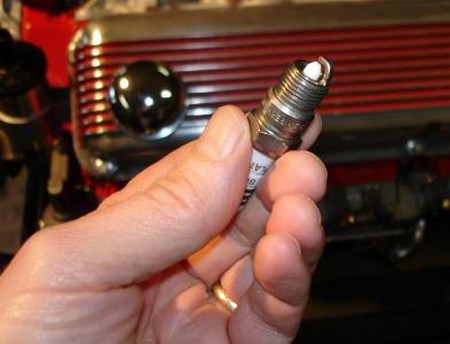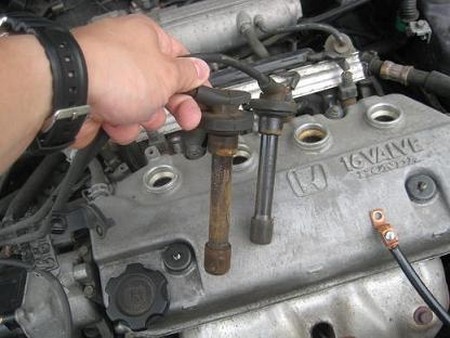Although the spark plugs currently in your car may be the type recommended in the owner’s and service manuals, they may not be the best ones for your engine. There are at least three different types of plugs that will serve an engine; their difference lies in the length of their noses. Spark plugs with a longer nose retain heat for a longer time than plugs with a shorter nose.

Car manufacturers generally recommend spark plugs having an intermediate nose length. Such plugs are recommended for normal driving conditions—that is, an equal or almost equal combination of engine idling, slow-speed, and high-speed operation.
Sometimes reports sent to a manufacturer from the field indicate that the intermediate-nose spark plug is ineffective under normal driving conditions. The manufacturer will then issue an advisory to new car dealer service departments recommending that a switch be made to a plug with a longer or shorter nose. The engine performance problem you are experiencing may be a result of not having this up-to-date information.
A spark plug with a long nose is recommended if an engine is used mainly for stop-and-go and slow-speed driving. An engine that operates under these conditions has a tendency to build up carbon particles. The heat retained by the long nose of this type of spark plug burns off particles that accumulate on electrodes and that can keep the plug from firing.
Conversely, a spark plug with a short nose is recommended if an engine is used mainly for high-speed driving. Under this type of operation, spark plugs fire more often, which causes them to overheat, resulting in rapid electrode wear. The shorter nose dispels heat quickly to prevent this problem.
If your engine displays one of the performance problems noted above, jot down the designation of the plugs now in your engine. The designation is written on the upper insulator. To read the numerals, you will probably have to remove a plug from the engine. Call the service department of a dealer who sells your make of vehicle and ask for verification that the plug designation is the one currently recommended by the manufacturer. If it is not, make the change.
Even if the designation is still valid, you may not be off the hook. The type of spark plug your engine needs depends on the type of driving you do. Remove one or two plugs from the engine and examine the lower insulator, which is the ceramic part that surrounds the center electrode of the plug. If the insulator is coated with soot, plugs are being fouled by carbon. Switch to a hotter, or longer, plug. If the insulator is stark white, plugs are overheating. Switch to a colder, or shorter, plug.
In making the switch from hotter to colder or from colder to hotter, move up or down the heat-range scale one notch at a time. Replace each of the old spark plugs with new plugs that are all of the same designation. Drive the vehicle for several days to determine whether the performance problem has been solved.
Here is how to remove and install spark plugs, whether they are of the wrong type or are simply worn. Worn plugs will cause hard starting and missing.
- Grasp the boot of each spark plug cable. Twist and pull the boot to remove it from the plug.
- Using an ear syringe, a piece of hose, or a drinking straw, blow dirt out of the spark plug ports to prevent particles from falling inside the engine as you remove the plugs. Particles can damage pistons and cylinder walls.
- Using a spark-plug wrench or a socket wrench of the correct size, turn the plugs counterclockwise to remove them.
- Notice whether the plugs have round or tapered seats. If round, they require seat gaskets. Spark plugs with tapered seats do not use gaskets.
- Before installing new plugs, set the gap between electrodes to the specification given in your owner’s manual or on the emissions-system information label mounted in the engine compartment. Slide a spark-plug feeler gauge of the correct size between the electrodes and move it from side to side. The electrode gap is set correctly when slight resistance is encountered as you move the gauge.
- To adjust the gap, use the special bending tang that is part of the feeler gauge. Bend the side (hooked) electrode to widen or narrow the gap until the correct setting is obtained.
- To install spark plugs, screw them into the engine until they tighten. Be careful not to cross threads.
- Then, if your engine uses spark plugs that require gaskets, tighten them 1/16 turn with a spark-plug or socket wrench. If the engine uses tapered-seat spark plugs, tighten them 1/16, of a turn with your wrench.









